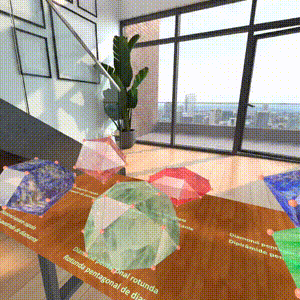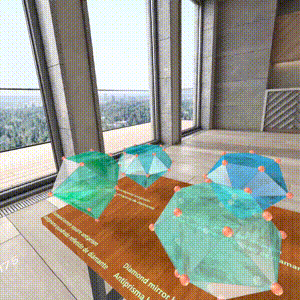Visualization of polyhedra with Augmented Reality (AR) and Virtual Reality (VR) in A-frame
author: Paulo Henrique Siqueira - Universidade Federal do Paraná
contact: paulohscwb@gmail.com
versão em português
 Diamond polyhedra
Diamond polyhedra
The polyhedra on this page were created by joining right pyramids with other whole or truncated polyhedra. In this way, we obtain the diamond polyhedra.
Augmented Reality | 3D Models | Home
Immersive rooms
🔗 room 1 | 🔗 room 2 | 🔗 room 3



Augmented Reality
To view diamond polyhedra in AR, simply visit:
https://paulohscwb.github.io/polyhedra2/diamonds/ra.html
with any browser with a webcam device (smartphone, tablet or notebook).
Access to the VR sites is done by clicking on the blue circle that appears on top of the marker.


3D models
1. Diamond triangular cupola


When we construct a right pyramid with a hexagonal base, which has the base coincident with the hexagonal face of a Johnson triangular cupola, we obtain a diamond triangular cupola.
Faces: 10 triangles and 3 squares | Edges: 21 | Vertices: 10. More…
2. Diamond square cupola


When we construct a right pyramid with a octagonal base, which has the base coincident with the octagonal face of a Johnson square cupola, we obtain a diamond square cupola.
Faces: 12 triangles and 5 squares | Edges: 28 | Vertices: 13. More…
3. Diamond pentagonal cupola


When we construct a right pyramid with a decagonal base, which has the base coincident with the decagonal face of a Johnson pentagonal cupola, we obtain a diamond pentagonal cupola.
Faces: 15 triangles, 5 squares and 1 pentagon | Edges: 35 | Vertices: 16. More…
4. Diamond pentagonal rotunda


When we construct a right pyramid with a decagonal base, which has the base coincident with the decagonal face of a Johnson pentagonal rotunda, we obtain a diamond pentagonal rotunda.
Faces: 20 triangles and 6 pentagons | Edges: 45 | Vertices: 21. More…
5. Diamond pentagonal dipyramid


If we construct a dipyramid using two right pentagonal pyramids with different heights, we obtain a diamond pentagonal dipyramid.
Faces: 10 triangles | Edges: 15 | Vertices: 7. More…
6. Diamond hexagonal dipyramid


If we construct a dipyramid using two right hexagonal pyramids with different heights, we obtain a diamond hexagonal dipyramid.
Faces: 12 triangles | Edges: 18 | Vertices: 8. More…
7. Diamond heptagonal dipyramid


If we construct a dipyramid using two right heptagonal pyramids with different heights, we obtain a diamond heptagonal dipyramid.
Faces: 14 triangles | Edges: 21 | Vertices: 9. More…
8. Diamond octagonal dipyramid


If we construct a dipyramid using two right octagonal pyramids with different heights, we obtain a diamond octagonal dipyramid.
Faces: 16 triangles | Edges: 24 | Vertices: 10. More…
9. Diamond square antiprism


Consider a modified antiprism, with a square base reduced by a factor between 0.6 and 0.8. If we construct a right square pyramid with the base coinciding with the largest base of the antiprism, we obtain a diamond square antiprism.
Faces: 12 triangles and 1 square | Edges: 20 | Vertices: 9. More…
10. Diamond pentagonal antiprism


Consider a modified antiprism, with a pentagonal base reduced by a factor between 0.6 and 0.8. If we construct a right pentagonal pyramid with the base coinciding with the largest base of the antiprism, we obtain a diamond pentagonal antiprism.
Faces: 15 triangles and 1 pentagon | Edges: 25 | Vertices: 11. More…
11. Diamond hexagonal antiprism


Consider a modified antiprism, with a hexagonal base reduced by a factor between 0.6 and 0.8. If we construct a right hexagonal pyramid with the base coinciding with the largest base of the antiprism, we obtain a diamond hexagonal antiprism.
Faces: 18 triangles and 1 hexagon | Edges: 30 | Vertices: 13. More…
12. Diamond heptagonal antiprism


Consider a modified antiprism, with a heptagonal base reduced by a factor between 0.6 and 0.8. If we construct a right heptagonal pyramid with the base coinciding with the largest base of the antiprism, we obtain a diamond heptagonal antiprism.
Faces: 21 triangles and 1 heptagon | Edges: 35 | Vertices: 15. More…
13. Diamond octagonal antiprism


Consider a modified antiprism, with a octagonal base reduced by a factor between 0.6 and 0.8. If we construct a right octagonal pyramid with the base coinciding with the largest base of the antiprism, we obtain a diamond octagonal antiprism.
Faces: 24 triangles and 1 octagon | Edges: 40 | Vertices: 17. More…
14. Diamond mirror square antiprism


Consider a modified antiprism, with a square base reduced by a factor between 0.6 and 0.8. Find the reflection of the smaller base of the antiprism relative to the larger base. By joining the vertex of a right square pyramid with the vertices of the largest base and the reflected antiprism base, we find a diamond mirror square antiprism.
Faces: 20 triangles and 1 square | Edges: 32 | Vertices: 13. More…
15. Diamond mirror pentagonal antiprism


Consider a modified antiprism, with a pentagonal base reduced by a factor between 0.6 and 0.8. Find the reflection of the smaller base of the antiprism relative to the larger base. By joining the vertex of a right pentagonal pyramid with the vertices of the largest base and the reflected antiprism base, we find a diamond mirror pentagonal antiprism.
Faces: 25 triangles and 1 pentagon | Edges: 40 | Vertices: 16. More…
16. Diamond mirror hexagonal antiprism


Consider a modified antiprism, with a hexagonal base reduced by a factor between 0.6 and 0.8. Find the reflection of the smaller base of the antiprism relative to the larger base. By joining the vertex of a right hexagonal pyramid with the vertices of the largest base and the reflected antiprism base, we find a diamond mirror hexagonal antiprism.
Faces: 30 triangles and 1 hexagon | Edges: 48 | Vertices: 19. More…
17. Diamond mirror heptagonal antiprism


Consider a modified antiprism, with a heptagonal base reduced by a factor between 0.6 and 0.8. Find the reflection of the smaller base of the antiprism relative to the larger base. By joining the vertex of a right heptagonal pyramid with the vertices of the largest base and the reflected antiprism base, we find a diamond mirror heptagonal antiprism.
Faces: 35 triangles and 1 heptagon | Edges: 56 | Vertices: 22. More…
18. Diamond mirror octagonal antiprism


Consider a modified antiprism, with a octagonal base reduced by a factor between 0.6 and 0.8. Find the reflection of the smaller base of the antiprism relative to the larger base. By joining the vertex of a right octagonal pyramid with the vertices of the largest base and the reflected antiprism base, we find a diamond mirror octagonal antiprism.
Faces: 40 triangles and 1 octagon | Edges: 64 | Vertices: 25. More…
19. Augmented tridiminished icosahedron


Johnson’s augmented tridiminished icosahedron can be considered a diamond polyhedron. It can be constructed by attaching a tetrahedron, seen as a triangular pyramid, to the triangular face of the tridiminished icosahedron which is connected only to the pentagons. It is the only Johnson solid that is constructed using decrease and increase, assuming that no decrease and increase cancel each other out.
Faces: 7 triangles and 3 pentagons | Edges: 18 | Vertices: 10. More…
20. Diamond augmented truncated tetrahedron


When we construct a right pyramid with a triangular base, which has a base coinciding with a triangular face opposite the triangular cupola, we obtain a diamond augmented truncated tetrahedron.
Faces: 10 triangles, 3 squares and 3 hexagons | Edges: 30 | Vertices: 16. More…
21. Diamond truncated snub square antiprism


When we construct a right pyramid with an octagonal base, joining the apex vertex of this pyramid with the 8 vertices of one of the symmetrical parts of a snub square antiprism, we obtain a diamond truncated snub square antiprism.
Faces: 20 triangles and 1 square | Edges: 32 | Vertices: 13. More…
22. Diamond triangular hebesphenorotunda


When we construct a right pyramid with a hexagonal base, which has the base coinciding with the hexagonal face of a triangular hebesphenorotunda, we obtain a diamond triangular hebesphenorotunda.
Faces: 19 triangles, 3 squares and 3 pentagons | Edges: 42 | Vertices: 19. More…
23. Diamond truncated triangular hebesphenorotunda


Consider a modified triangular hebesphenorotunda, disregarding the hexagonal face and all other faces that are joined with the hexagon vertices. The solid obtained by joining a right pyramid with an enneagonal base with the other faces of the modified triangular hebesphenorotunda is a diamond truncated triangular hebesphenorotunda.
Faces: 13 triangles and 3 pentagons | Edges: 27 | Vertices: 13. More…
24. Diamond truncated triangular hebesphenorotunda


Consider a modified triangular hebesphenorotunda, disregarding the pentagonal faces and the triangular face that is joined only with the pentagons vertices. The solid obtained by joining a right pyramid with an enneagonal base with the other faces of the modified triangular hebesphenorotunda is a diamond truncated triangular hebesphenorotunda.
Faces: 18 triangles, 3 squares and 1 hexagon | Edges: 36 | Vertices: 16. More…
25. Diamond truncated dodecahedron


Consider a modified dodecahedron, disregarding one face and the 5 faces that are joined with this disregarded face. The solid obtained by joining a right decagonal pyramid with a the other faces of the modified dodecahedron is a diamond truncated dodecahedron.
Faces: 10 triangles and 6 pentagons | Edges: 30 | Vertices: 16. More…
26. Diamond truncated square pyramid


When we construct a right square pyramid, which has the base coinciding with the base of a truncated square pyramid, we obtain a diamond truncated square pyramid.
Faces: 4 triangles, 1 square and 4 trapezoids | Edges: 16 | Vertices: 9. More…
27. Diamond truncated pentagonal pyramid


When we construct a right pentagonal pyramid, which has the base coinciding with the base of a truncated pentagonal pyramid, we obtain a diamond truncated pentagonal pyramid.
Faces: 5 triangles, 1 pentagon and 5 trapezoids | Edges: 20 | Vertices: 11. More…
28. Diamond truncated hexagonal pyramid


When we construct a right hexagonal pyramid, which has the base coinciding with the base of a truncated hexagonal pyramid, we obtain a diamond truncated hexagonal pyramid.
Faces: 6 triangles, 1 hexagon and 6 trapezoids | Edges: 24 | Vertices: 13. More…
29. Diamond truncated heptagonal pyramid


When we construct a right heptagonal pyramid, which has the base coinciding with the base of a truncated heptagonal pyramid, we obtain a diamond truncated heptagonal pyramid.
Faces: 7 triangles, 1 heptagon and 7 trapezoids | Edges: 28 | Vertices: 15. More…
30. Diamond truncated octagonal pyramid


When we construct a right octagonal pyramid, which has the base coinciding with the base of a truncated octagonal pyramid, we obtain a diamond truncated octagonal pyramid.
Faces: 8 triangles, 1 octagon and 8 trapezoids | Edges: 32 | Vertices: 17. More…
31. Diamond truncated disdyakis dodecahedron


When we construct a right octagonal pyramid, with its main vertex united with the truncated Catalan disdiakis dodecahedron vertices, we obtain a diamond truncated disdiakis dodecahedron.
Faces: 32 triangles | Edges: 48 | Vertices: 18. More…
32. Diamond truncated triakis icosahedron


When we construct a right decagonal pyramid, with its main vertex united with the truncated Catalan triakis icosahedron vertices, we obtain a diamond truncated triakis icosahedron.
Faces: 30 triangles | Edges: 45 | Vertices: 17. More…
33. Diamond truncated pentakis dodecahedron


When we construct a right decagonal pyramid, with its main vertex united with the truncated Catalan pentakis dodecahedron vertices, we obtain a diamond truncated pentakis dodecahedron.
Faces: 30 triangles | Edges: 45 | Vertices: 17. More…
34. Diamond truncated pentagonal hexecontahedron


When we construct a right pentadecagonal pyramid, with its main vertex united with the truncated Catalan pentagonal hexecontahedron vertices, we obtain a diamond truncated pentagonal hexecontahedron.
Faces: 15 triangles and 15 pentagons | Edges: 60 | Vertices: 32. More…

Diamond polyhedra - Visualization of polyhedra with Augmented Reality and Virtual Reality by Paulo Henrique Siqueira is licensed with a license Creative Commons Attribution-NonCommercial-NoDerivatives 4.0 International.
How to cite this work:
Siqueira, P.H., "Diamond polyhedra - Visualization of polyhedra with Augmented Reality and Virtual Reality". Available in: <https://paulohscwb.github.io/polyhedra2/diamonds/>, November 2023.
References:
Weisstein, Eric W. “Archimedean Solid” From MathWorld-A Wolfram Web Resource. http://mathworld.wolfram.com/ArchimedeanSolid.html
Weisstein, Eric W. “Platonic Solid” From MathWorld-A Wolfram Web Resource. http://mathworld.wolfram.com/PlatonicSolid.html
Weisstein, Eric W. “Uniform Polyhedron.” From MathWorld–A Wolfram Web Resource. https://mathworld.wolfram.com/UniformPolyhedron.html
Weisstein, Eric W. “Johnson Solid” From MathWorld-A Wolfram Web Resource. https://mathworld.wolfram.com/JohnsonSolid.html
Wikipedia https://en.wikipedia.org/wiki/Archimedean_solid
Wikipedia https://en.wikipedia.org/wiki/Platonic_solid
McCooey, David I. “Visual Polyhedra”. http://dmccooey.com/polyhedra/